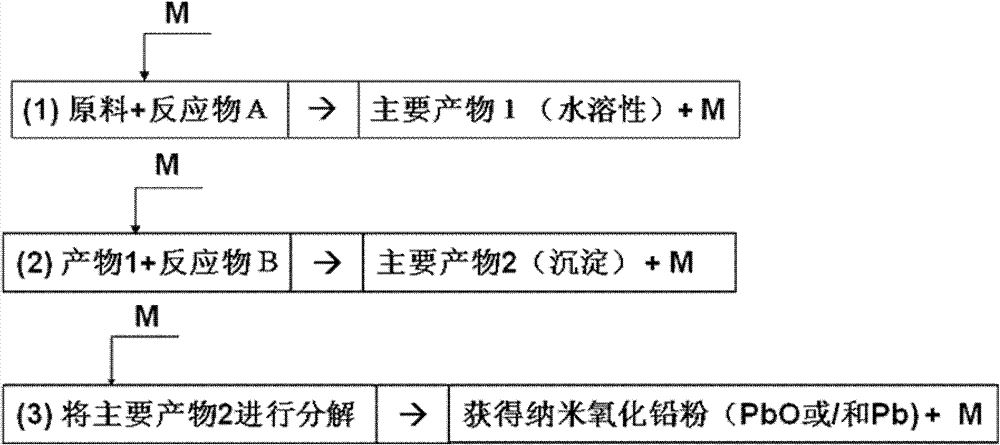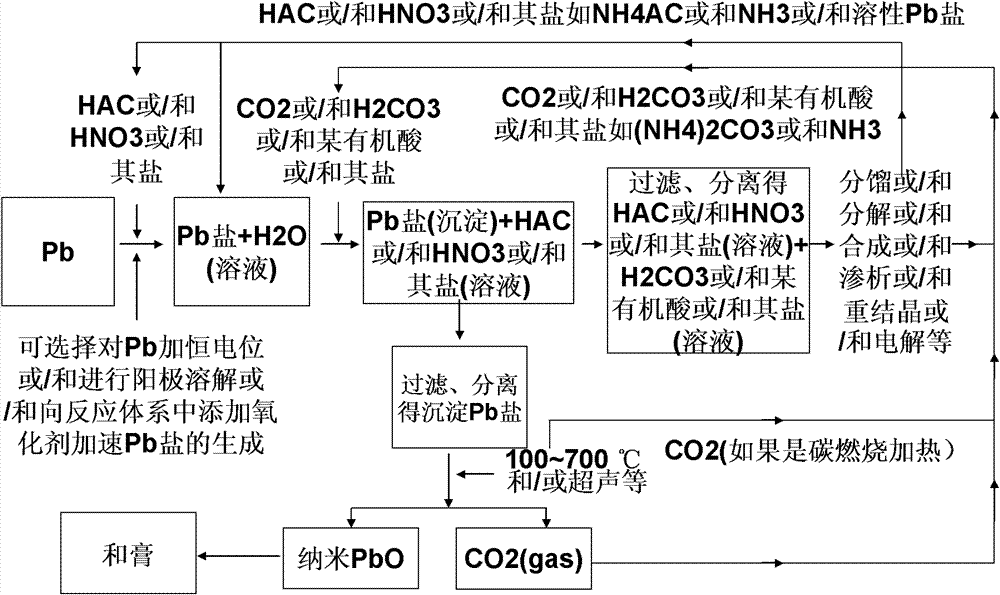Preparation method of lead-acid battery pbo nano powder
A lead-acid battery, nano-powder technology, applied in nanotechnology, battery recycling, lead oxide and other directions, can solve the problems of difficult commercial production and application, high process cost, unsuitable for lead-acid battery recycling and manufacturing process, etc. Achieve the effect of reducing production cost, simplifying process and shortening production cycle
- Summary
- Abstract
- Description
- Claims
- Application Information
AI Technical Summary
Problems solved by technology
Method used
Image
Examples
Embodiment 1
[0059] The preparation method of lead-acid accumulator lead oxide (PbO) nanopowder of the present invention, its schematic flow sheet, as specification attached Figure 5 As shown, the steps include:
[0060] (1) Mix 0.1kg of lead powder (containing about 0.457mol Pb) with 0.11kg or 1.1kg or 98kg of 50% acetic acid solution (containing about 0.457mol or 0.9mol or 9 or 457mol or 800mol of acetic acid) solution, and React at 25°C for 1 or 30 minutes while stirring to dissolve the lead powder in the solution; wherein, this step can be supplemented with ultrasound; the unreacted part of the lead powder can be taken out and mixed with the next batch of lead powder;
[0061](2) At room temperature (25°C), feed 0.02kg or 0.2kg or 20kg (about 0.457mol or 4.57mol or 457mol) of CO into the solution of dissolved lead salt (lead acetate) 2 ;
[0062] (3) Filter the solution system after the reaction to obtain the precipitate and the solution respectively. Thermally decompose the precip...
Embodiment 2
[0065] The preparation method of the lead oxide nanopowder of the present invention, its schematic flow sheet, as description attached Figure 6 As shown, the steps include:
[0066] (1) Mix 0.1kg of lead powder (containing about 0.457mol Pb) with 0.11kg or 1.1kg or 98kg of 50% acetic acid solution (containing about 0.9mol or 9mol or 90mol of acetic acid) and mix it under room temperature (25°C) React for 1 or 30 minutes while stirring to dissolve the lead powder in the solution; wherein, this step can be supplemented with ultrasound; the unreacted part of the lead powder can be taken out and mixed with the next batch of lead powder.
[0067] (2) Add 0.028kg or 0.28kg or 28kg (about 0.457mol or 4.57mol or 457mol) of urea to the solution of dissolved lead salt (lead acetate), heat (25-99°C) to decompose the urea and allow the reaction to occur.
[0068] (3) Filter the solution system after the reaction to obtain the precipitate and the solution respectively. Heat and decompos...
Embodiment 3
[0071] The preparation method of the lead oxide nanopowder of the present invention, its schematic flow sheet, as description attached Figure 7 As shown, the steps include:
[0072] (1) Mix 0.1kg of lead powder (about 0.457mol Pb) with 0.11kg or 1.1kg of acetic acid (25%) + sodium acetate (25%) solution (about 0.79mol or 7.9mol of acetate), and React at room temperature (25°C) for 1 or 30 minutes while stirring to dissolve the lead powder in the solution; wherein, this step can be supplemented with ultrasound; the unreacted part of the lead powder can be taken out and mixed with the next batch of lead powder .
[0073] (2) Add 0.038kg or 11.4kg (about 0.457mol or 13.71mol) of sodium bicarbonate to the solution of dissolved lead salt (lead acetate), heat (30-99°C) to decompose the sodium bicarbonate and allow the reaction to occur.
[0074] (3) Filter the solution system after the reaction to obtain the precipitate and the solution respectively. Heat and decompose the preci...
PUM
| Property | Measurement | Unit |
|---|---|---|
| particle diameter | aaaaa | aaaaa |
| particle diameter | aaaaa | aaaaa |
| particle diameter | aaaaa | aaaaa |
Abstract
Description
Claims
Application Information
 Login to View More
Login to View More - R&D
- Intellectual Property
- Life Sciences
- Materials
- Tech Scout
- Unparalleled Data Quality
- Higher Quality Content
- 60% Fewer Hallucinations
Browse by: Latest US Patents, China's latest patents, Technical Efficacy Thesaurus, Application Domain, Technology Topic, Popular Technical Reports.
© 2025 PatSnap. All rights reserved.Legal|Privacy policy|Modern Slavery Act Transparency Statement|Sitemap|About US| Contact US: help@patsnap.com



